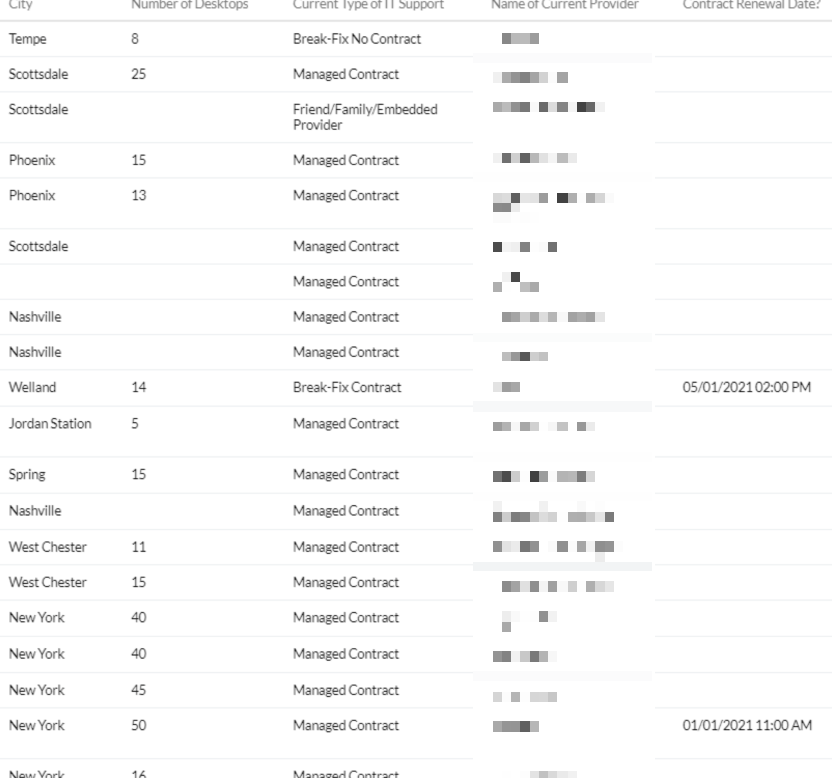 There is one fact in the managed services space that can’t be ignored: everyone has I.T. support. Those who already understand and value managed I.T. services are already buying it. Your whole sales process is now built around displacing competitors.
There is one fact in the managed services space that can’t be ignored: everyone has I.T. support. Those who already understand and value managed I.T. services are already buying it. Your whole sales process is now built around displacing competitors.
This means your competitors’ sales processes are built around displacing you.
Nobody is happy with their vendor all the time. Your services aren’t perfect all the time. Sales is most often luck and timing. A sales relationship begins when someone engages with a prospect at the exact right moment. The better your sales process, the more often that happens.
Rub salt in the wound
At Managed Sales Pros we teach our callers to rub salt in that wound. All day, every day, we pick apart the service delivery of other managed services providers. We make thousands of outbound calls daily with the sole purpose of finding companies who are not happy with their current MSP. We track things in the market so that we can identify what companies are failing, and where they fall down. Once we know that a company botched an onboard for a 50-seat law firm three months ago, we can assume that this was not the first time. And it will not be the last time.
We now know that every time we come up against that company in the market and a current client says “we’re happy with what we have,” we can ask them a question about their on-boarding experience to start the displacement process. Maybe they’re not so happy after all. It is my job to keep leading that new prospect down the road of unhappiness. If their current MSP makes an error in the few weeks after our reminder, the odds of us getting a call back for OUR client increase significantly.
We’ve been doing this for seven years and we’re good at it. So are a lot of your competitors. The good news: you can create a good user experience for your clients by maintaining your brand promise, which will make most of your client roster poach-proof.
We don’t often hear “I love my IT Company, I would never leave them”. What we do often hear is “it would be really inconvenient to change.” Think about any vendor you work with that you don’t actually like working with, but you can’t imagine the horror show that changing vendors would create in your business. Unfortunately, that is how most business owners view their MSPs. They’re not crazy about you, but you’re the devil they know.
Preparing for a displacement sales attack
Below, I have identified the top three issues that make it even easier for a competitor to begin a displacement sales attack:
-
- Badly managed growth cycles
Our company alternates between “growth” years and “process” years. In a growth year we value client acquisition. In a process year we place a higher value on service delivery. During growth years we run the risk of losing some current clients. Process years mean slower growth and higher retention. Alternating years allows us to maintain acceptable levels of attrition while we improve service delivery.
Often, when an MSP lands their first “whale” client or wins some back-to-back deals, their service delivery takes a dip. If you aren’t able to effectively predict your sales cycles and staff accordingly, you probably are a little short-staffed when that new client comes on, and your current clients – even if they don’t talk to you about it – notice that they have dropped on your priority list. It is easier and less expensive to keep clients than it is to sign new ones – if your sales process is creating a rotating door, you’ll work twice as hard for half as much.
-
- Circumventing process for wins
The prospect has a timeline that is out of the scope of your regular process. You need a month to onboard properly, but they want to change NOW, and you want to win this deal. You promise your client you’ll get them live on their timeline instead of yours. You miss the deadline, or something else gets missed in the rushed approach.
Relationships that begin with disappointment are hard to recover from. When we identify that a company regularly misses their deadlines and SLAs, we can now remind any client that works with them that their MSP isn’t that reliable and didn’t do what they promised. Maybe it’s time to shop around? A competitive quote couldn’t hurt, right?
-
- M&A
Something always gets lost in the shuffle when two or more companies merge. That personalized service, or boutique feel that clients enjoyed, gets scaled back in the name of profitability and the buyer’s standard operating procedures. If you’re preparing for an acquisition, prepare your account managers. The more you talk to your clients through the process, the less likely the exodus.
Remember, we’re tracking our client’s competitors, and we know who they support. When a merger is announced in a client market, a full-blown attack campaign starts against both of those companies’ client lists. And we are relentless.
What’s the point?
You can make these strategies work for you instead of against you by listening to the market, tracking trends and creating competitive battle cards. Adding some user-defined fields to your PSA or CRM is a great place to start.
On October 22nd at 2 PM (ET), join me as I share some ideas for displacing your competitors while poach-proofing your own client roster.
Photo: REDPIXEL.PL / Shutterstock

[…] Review this article from SmarterMSP identifies the times when you need to pay the most attention to … […]
[…] of free text entry. For example, you may want to create a picklist of your competitors if you’re collecting data on who your prospects are currently working with. This allows you to search for all contacts using a certain competitor, and ideally tailor […]